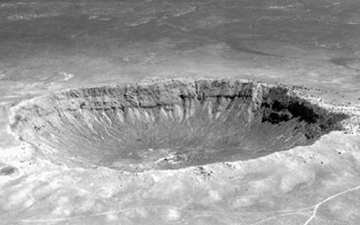A meteorite is a solid piece of debris, from such sources as asteroids or comets, that originates in outer space and survives its impact with the Earth’s surface. It is called a meteoroid before its impact. A meteorite’s size can range from small to extremely large. When a meteoroid enters the atmosphere, friction, pressure, and chemical interactions with the atmospheric gases cause it to heat up and radiate that energy, thus forming a fireball, also known as a meteor or shooting/falling star. A bolide is either an extraterrestrial body that collides with the Earth, or an exceptionally bright, fireball-like meteor regardless of whether it ultimately impacts the surface.
More generally, a meteorite on the surface of any celestial body is a natural object that has come from outer space. Meteorites have been found on the moon[1][2] and Mars.[3] Meteorites that are recovered after being observed as they transit the atmosphere or impact the Earth are called meteorite fall. All other meteorites are known as finds. As of February 2010, there are approximately 1,086 witnessed falls having specimens in the world’s collections. There are more than 38,660 well-documented meteorite finds.[4]
Meteorites have traditionally been divided into three broad categories: stony meteorites are rocks, mainly composed of silicate minerals; iron meteorites that are largely composed of metallic iron-nickel; and, stony-iron meteorites that contain large amounts of both metallic and rocky material. Modern classification schemes divide meteorites into groups according to their structure, chemical and isotopic composition and mineralogy. Meteorites smaller than 2mm are classified as micrometeorites.
(From Wikipedia, February 2015)


